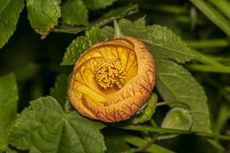Abutilon Pruning Tips: When To Prune A Flowering Maple


Abutilon plants are showy perennials with maple-like leaves and bell-shaped flowers. They are often called Chinese lanterns because of the papery blossoms. Another common name is flowering maple, because of the lobed leaves. Trimming abutilon is essential to their continued health and beauty. You’ll need to learn how to prune an abutilon if you are growing one of these plants. Read on for information on trimming abutilon as well as abutilon pruning tips.
Pruning Abutilon Plants
Abutilon plants are native to South America, Africa, and Australia. They are tender evergreens that need a growing site with some sun to produce the lovely, lantern-shaped flowers. They also need some shade to thrive. Why do you need to think about pruning these plants? Abutilons get leggy as they grow. Most plants are prettier and more compact if you start pruning abutilon plants regularly. In addition, broken or diseased branches can allow in or pass on infection. Pruning out damaged and diseased branches is essential. If you are wondering when to prune a flowering maple, think late winter or early spring. Abutilon plants flower on current growth. That means that you’ll have more flowers if you prune a flowering maple before spring growth begins.
How to Prune an Abutilon
When you start pruning abutilon plants, you’ll always want to sterilize your pruners first. It’s one of the most important abutilon pruning tips and prevents the spread of disease. The next step in how to prune an abutilon is to remove any and all plant parts that suffered winter damage, as well as other damaged or dead shoots. Remove the branches just above a stem junction. Otherwise, trimming abutilon is a matter of personal taste. You prune a flowering maple to create the look and shape you want. Another one of those abutilon pruning tips; never prune a flowering maple by removing more than one-third of a stem. That leaves the plant with enough resources to maintain its vitality. However, if you find that the plant is too dense, you can remove bare or aging stems. Just cut them at the plant’s base.
Gardening tips, videos, info and more delivered right to your inbox!
Sign up for the Gardening Know How newsletter today and receive a free download of our most popular eBook "How to Grow Delicious Tomatoes."

Teo Spengler has been gardening for 30 years. She is a docent at the San Francisco Botanical Garden. Her passion is trees, 250 of which she has planted on her land in France.
-
 Urban Composting Guide: How To Compost In The Middle Of The City
Urban Composting Guide: How To Compost In The Middle Of The CityUrban composting does not have to be daunting. You can compost in the city, and maybe even try some urban worm composting!
By Mary Ellen Ellis
-
 Shrub Diseases And Pests To Watch Out For
Shrub Diseases And Pests To Watch Out ForShrub diseases and pests can be challenging. Learn how to recognize and eradicate them before they can present a danger to your plants.
By Susan Albert
-
 What Is Abutilon? Tips For Flowering Maple Care Outdoors
What Is Abutilon? Tips For Flowering Maple Care OutdoorsAlso known as flowering maple, parlor maple, Chinese lantern or Chinese bellflower, abutilon is an upright, branching plant with leaves that resemble maple leaves. This plant is often grown as a houseplant, but can you grow abutilon in the garden too? Find out here.
By Mary H. Dyer
-
 Growing Abutilon Flowering Maple: Learn About Abutilon Requirements Indoors
Growing Abutilon Flowering Maple: Learn About Abutilon Requirements IndoorsThe flowering maple is striking enough to make a lovely specimen plant in the garden or in a container inside. Learn more about growing flowering maple plants in the following article.
By Amy Grant